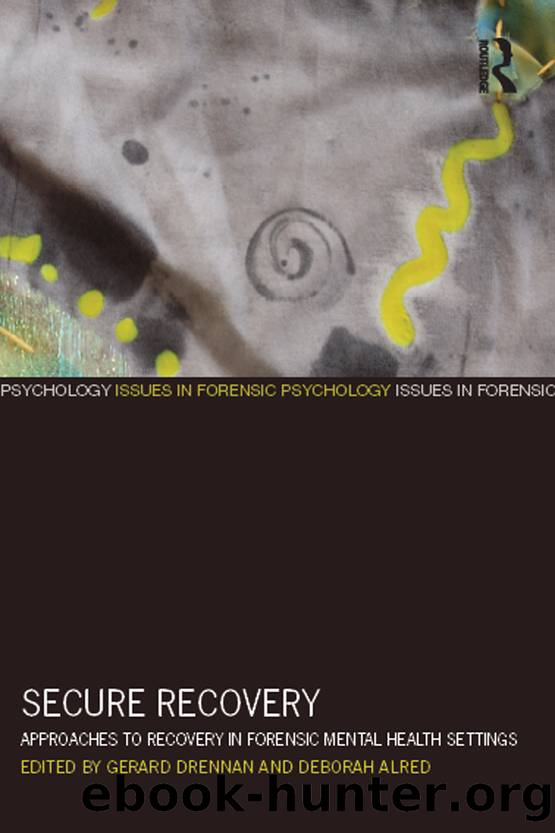Secure Recovery by Drennan Gerard;Alred Deborah;Shuker Richard;

Author:Drennan, Gerard;Alred, Deborah;Shuker, Richard;
Language: eng
Format: epub
Publisher: Willan Publishing
7 Recovering personhood
Using recovery principles
on a long-stay medium secure ward
Jay Smith and Veronica Garcia
Introduction
In late 2003 we opened a 15-bedded ward in the Forensic Directorate of the East London NHS Foundation Trust. Our long-term rehabilitation ward was established for the treatment of male service users who had spent many years in secure psychiatric settings. In psychiatric language, they demonstrated a combination of ongoing psychotic symptoms, behavioural problems, personality disorder and risk. As people, our service users shared a common background of neglectful, abusive or chaotic parenting, which greatly compromised their ability to trust themselves, other people or their environment. These adverse life experiences contributed to an inability to receive help and work collaboratively with others, which at least partly explained how they had found themselves spending a large part of their adult lives in institutions.
In this chapter we seek to describe how the application of recovery principles within the ward setting helped our users to take the first step on the road to recovery: namely, the rediscovery of their personhood. As Anthony (2004) states, âpeople want to self-determine their own goals, be involved in their own lives, believe in their capacity to grow and have hopeâ. Although this statement is simple and self-evident, as with so many simple principles difficulties arise when translating it into practice. Without careful attention, secure psychiatric hospitals readily become dehumanizing environments, riven by fear, persecutory anxiety and ruthless struggles over power and control. Such environments often iterate the service userâs difficulties (Cordess, 2006) by, for example, emphasizing power at the expense of relatedness or by dismissing the importance of attachments. All who have worked in secure psychiatric institutions will have experienced the shockingly abrupt transfers of staff and patients or witnessed the almost âknee-jerkâ repressive response to an infraction of one of the many rules. As Hyatt-Williams (1998 ; p. 217) rightly points out, such environments can promote stasis, but not change.
In designing the ward, we thus had to meet a number of potentially conflicting aims. We had to maintain safety and adhere to the structures of the institution while offering our users a different experience, one that would allow them to rediscover their personhood. For some of our users, we were offering long term care or a âhomeâ as some patients have come to describe it â but we had to make room for the possibility that things might change in a way that would allow some individuals to leave the ward to start a new life elsewhere. We had to have hope for our users, but also acknowledge that such hopes may not be fulfilled.
(Frey-Wehrlin et al., 1989)
This chapter describes aspects of the recovery approach used in our particular community. We describe the structures and approaches we use, all of which has been informed by what our service users have taught us about being a person with mental illness. Several of our service users have contributed aspects of their stories, for which we thank them. We have removed any identifying information to preserve their privacy.
Download
This site does not store any files on its server. We only index and link to content provided by other sites. Please contact the content providers to delete copyright contents if any and email us, we'll remove relevant links or contents immediately.
| Adult Children of Alcoholics | Alcoholism |
| Drug Dependency | Gambling |
| Hoarding | Obsessive Compulsive Disorder (OCD) |
| Sexual | Smoking |
| Substance Abuse | Twelve-Step Programs |
The Hacking of the American Mind by Robert H. Lustig(4111)
Right Here, Right Now by Georgia Beers(3941)
Fingerprints of the Gods by Graham Hancock(3763)
Goodbye Paradise(3473)
Bad Pharma by Ben Goldacre(3118)
Happiness by Matthieu Ricard(2894)
More Language of Letting Go: 366 New Daily Meditations by Melody Beattie(2866)
The Social Psychology of Inequality by Unknown(2782)
Drugs Unlimited by Mike Power(2491)
The Plant Paradox by Dr. Steven R. Gundry M.D(2441)
Confessions of a Shopaholic by Sophie Kinsella(2178)
Borders by unknow(2127)
Dry by Augusten Burroughs(2003)
Make Love Not Porn by Cindy Gallop(1989)
Stop Being Mean to Yourself: A Story About Finding the True Meaning of Self-Love by Melody Beattie(1902)
Getting Off by Erica Garza(1859)
Yoga and the Twelve-Step Path by Kyczy Hawk(1757)
Belonging by Unknown(1743)
Unmasking Male Depression by Archibald D. Hart(1732)
